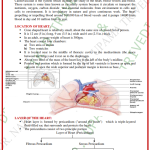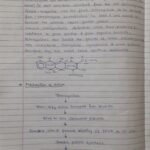page
wwwww..DDu ulloMiix.ccoomm
‘Introduction
¢-Fundamental principles and theory -Coupling co nstant
¢Instrumentation -2D-NMR
‘Solvents -NOE
¢Chemical shift -NOESY
¢Factors affecting chemical shift -COSY
‘Interpretation of proton -Applications
NMR spectra
Proton chemical shifts
wwwww.D.DuluoloMMixix..ccoomm Page 2
Nuclear Magnetic Resonant
technique which is based on the absorption of ele
in the radio frequency region 4 to 900 MHz by nuclei of the
atoms.
Proton Nuclear magnetic resonance spectroscopy is one of the
most powerful tools for elucidating the number of hydrogen or proton
in the compound.
It is used to study a wide variety of nuclei:
@ 1H 15N
+195 OF
13C 31
www.wDu.DluolMoiMxi.xc.coomm Page 3
Spin quantum number
the atomic and mass number of the nucle
i Atomic Atomic | Examples
Mass Number
Half- Odd Odd 1H (1/2)
integer NMR active
Half- Odd Even 13C (1/2)
integer
Integer Even Odd 2H (1)
zero Even Even 12C (0) Not NMR
active
Elements with either odd mass or odd atomic
number have the property of nuclear “spin”.
wwwww.D.DuluoloMMixix..ccoomm Page 4
possible orientations calculated by”
Hydrogen has spin quantum number I=1/:
possible orientation is (2*1/2+1=2) two +1/2 and -1/2.
Applied magnetic field
Energy +
etree
Spin state J=-1/2 (B) Precessional .~
n n dee Oe
Spinning
nucleus
ser tmen..
Spin state J =+1/2 (a)
meee eo
Field strength By :
wwwww.D.DuluoloM Mixix..ccoomm
J a”
The theory behind NMR com 7
from the spin of a nucleus and it QQ
o” Or
generates a magnetic field. Without an P
On
external applied magnetic field, the
No external magnetic field
nuclear spins are random in directions.
But when an external magnetic
o 9 9
field(B,), is present the nuclei align é
themselves either with or against the } > ?
?
field of the external magnet. ?
With external magnetic field
wwww..DDuulloMiix.ccoomm
External magnetic field
applied, an energy transfer (AE)
possible between ground state to
excited state. +4(ore) -4(or 6)
when the spin returns to its Spin Energy States
ground state level, the absorbed
radiofrequency energy is emitted at A he,
y -spin state
the same frequency level. UL’
PS AE
The emitted radiofrequency ‘2 <
c th
signal that give the NMR spectrum of Pe s
” Q-spin state
the concerned nucleus. ¥
Applied Magnetic
aes Field Strength —e
Increases
Bo
www.wD.uDluolMo iMxi.x c.coomm raye f
The em itted radio fre
to the strength of the applied field.
B = External magnetic field experienced by proton
y = Magnetogyric ratio ( The ratio between the nuclear
magnetic moment and angular moment)
www.wD.uDluolMo iMxi.xc.coomm Page 8
RS.
Int + shielded
ntensity ae
d eshi elded nuclei nuclei
TMS
downfield <— upfield
Frequency
5
The NMR spectrum is a plot of intensity of NVR
signals VS magnetic field (frequency) in reference to TMS
www.wD.uDluolMoiMxi.xc. coomm Page 9
1. Sample holder :
2. Permanent magnet 5. Radio fi
3. Magnetic coils 6. Radio frequen
7.Read out systems
radiofrequency radiofrequency |
transmitter amplifier | : detector |
audio |
amptitier | ha Fu—]
oscilloscope
and /or
recorder
sweep
generator
www.wD.uDlu olMoiMxi.xc.coomm — 0
1.Sample holder :- Glas s tube
in diameter
2.Permanent magnet _:- It provides homogeneous magnetic
field at 60-100 MHZ
3.Magnetic coils :- These coils induce magnetic field
when current flows through them.
4.Sweep generator :- To produce the equal amount of
magnetic field pass through the sample
www.wDu.DluolMo iMxi.xc.coomm Page 11
5-Radio frequency _ :- A radio transmitter
transmitter that produces a short powerful
pulse of radio waves
6.Radiofrequency —:- A radio receiver coil that detects Receiver
radio frequencies emitted as
nuclei relax to a lower energy level
7.Readout system — :- A computer that analyses
and record the data
www.wDu.DluolMo iMxi.xc.coomm Page 12
The fol lowing solvents are normally used in wh
hydrogen replaced by deuterium.
CCl4 _ – carbon tetrachloride
CS2__- carbon disulfide
CDClg – Deuteriochloroform
C6D6 – Hexa deuteriobenzene
D,O – Deuterium oxide
wwwww.D.DuluoloMMixix..ccoomm Page 13
A chemical shift is defined as the differe
per million (ppm) between the resonance frequency of the
observed proton and tetramethylsilane (TMS) hydrogens.
TMS is the most common reference compound in NMR,
it is set at6=0 ppm
Chennical si, 3 = frequency of signal – frequency of reference aT
spectrometer frequency
www.wDu.DluolMo iMxi.xc.coomm Page 14
High electron der
nucleus from the external magnetic f
upfield in the NMR spectrum
Deshielding of protons:-
Lower electron density around a nucleus deshields
the nucleus from the external magnetic field and the
signals are downfield in the NMR spectrum
I : | I
10 = 8 7 6 >
wwww.w .HDuublo iMixix..ccoomm
=
—{
4
—
4
—
—
+
4
—
4
—{
=~
—
4
4
lectronegative groups
¢ Magnetic anisotropy of m-systems
¢ Hydrogen bonding
Electronegative groups:-
Electronegative groups attached to the C-H system
decrease the electron density around the protons, and there is
less shielding (7.e.deshielding) and chemical shift increases
CH,I 2.16
CH,Br 2.65
CH,Cl 3.10
CHF 4.26
www.wD.uDluolMoiMxi.xc.c oomm Page 16
The wo rd “anisotropic !
anisotropy means that there is a “non-uni
> Electrons in 1 systems (e.g. aromatics, alk enes, alky nes, ¢
etc.) interact with the applied field which induces a magnetic field that
causes the anisotropy.
> It causes both shielding and deshielding of protons.
> Example:-Benzene
Hydrogen bonding:-
> Protons that are involved in hydrogen bonding are typically change
the chemical shift values.
> The more hydrogen bonding, the more proton is deshielded and
chemical shift value is higher. — wwwww.d.Duluolom Mixix..ccoomm Page 17
The most common for of NMR is based on the
hydrogen-1 (*H), nucleus or proton.
It can give information about the structure of any
molecule containing hydrogen atoms.
www.wDu.DluolMoiMxi.xc.coomm Page 18
Approximate Approximate Type af Ap proximate Approximate
chemical sWin chemical shift
Type of proton ¢ppen) (pem) carbon chemical shift (ppm) chemical shift (ppm)
(CHyS 0
4S-—8 (CH), Si Oa
—CH; 0.9
RCH 3-63
8.3 90-10
—ey— 4$=80
14
2S—4 R=CHy—R 60
S80
—CmC—CHy 1.7
24=4
0 ROHR 20-4) 165-178
—d_ ch,
4
R—C—R 3040) 168-178
41—i5
—CaeC—H
R=—O—CH, Variable. | 4-4
=C 6$-85 178-188
Variable, 2-5
R—C CH;
Alt Variable, 4-7
R—C-C—H
kk ee Variable, 10-12
0
— tnt; Variable. £-8
OTe wee oC ppmumae Doomed Oey wt cMEctal by oo Girton goatee teu 100=1 $0 190—20X)
CF 110-170 208-220
wwwww.D.DuluoloMMixix..ccoomm rage TJ
H NMR Table
==
= O— cC—
fe)
BA SD
= (ByC1¢c — —
o (H)
I N —c-—@® |
ee pi ecas
6 Hy
Cease Mize See A
nine ee “@
yD Pind on Pol’y hat
feo ae E :
ppm,
www.Dulo 4w .DuloMiMxi.xc.coomm Page 20
fy e
T T T T T T
8 ¥ 6 5 4 3 2 1 0
6(ppm)
‘H spectrum of Ethanol:-
3 types of proton
CH, CH, OH
www.wDu.DluolMo iMxi.xc.coomm Page 21
|
fF oe” § 7 he , * | * 0
PPM
cal shift scale 6.5-8.0 ppm.
– Aromatic Hydrogen shows peak in the chemi
of protons and it shows
– From the above spectrum Benzene has same type
single peak at 7.26
Page 22
wwwww..DDuulloMiix.ccoomm
Number of signals – Indicates how many “diffe
protons are present.
Position of signals – Indicates something about (chemicalshift)
magnetic (electronic) environment of protons
Relative intensity of – Proportional to number of protons present
signals
Splitting of signals – Indicates the number of nearby nuclei
(spin spin coupling) usually protons
www.wDu.DluolMoiMxi.xc.coomm Page 23
: The multiplicity of signal is cale
A?° ° This is one of the rule to predict the splitting of proton
signals. This is considered by the nearby hydrogen nuclei.
Therefore, n= Number of protons in nearby nuclei
> Zero H atom as neighbour n+1=0+1=1(singlet)
> One H atom as neighbour n+1=1+1 = 2(doublet)
> Two H atom as neighbour n+1=2+1 =3(triplet)
www.wDu.DluolMo iMxi.xc.coomm Page 24
The interaction b etween
nuclei in a molecule may cause the sphitt
spectrum.This is known as spin-spin coupling OF ST
The splitting pattern is related to the number of
equivalent H-atom at the nearby nuclei.
pin-Spin Splitting patterns
mg acetate
S
CH, 1. Singlet. 3 equivalent
me protons. Not coupled to any
es hy en<-0 ppm neighboring protons.
/ 3 2. Quartet. 2 equivalent
Ps protons. Split (1°3:3°1)
3 because coupled to the 3
‘Hs at the 2 position
6=4.1 ppm ppm | 3. Triplet. 3 equivalent
protons. Split (1.2.1)
2 because coupled to the 2
1Hs at the 3 position.
wwwww..DDuulloMiix.ccoomm
Wi
* Chemically equi valent protons do no ts
* Only nonequivalent protons couple.
in t ; in 1 H, couples with H..
H—C—C—C—C—H H, and H, do not couple because they are equivalent.
| | | | H. and H, do not couple because they are equivalent.
* Protons on adjacent carbons normally will couple.
* Protons separated by four or more bonds will not couple.
a a i H, can couple with H,
H .—c—c—c H, can couple with H,
a
H, cannot couple with H,
www.wDu.DluolMoiMxi.xc.coomm _age 26
The distance between the
a measure of the splitting effect known as cot DTS “CO
° It is denoted by symbol J, expressed in Hz.
. Coupling constants are a measure of the effectiveness
of spin-spin coupling and very useful in ‘H NMR of complex
structures.
www.wDu.DluolMoiMxi.xc.coomm Page 27
cs of 2D NM R Experiment:-
Basis: Interaction of nuclear spins (‘H with 1H, !
dimensions
* Normal spectra( 1D NMR) are plots of intensity Vs frequency.
* In 2D NMR intensity is plotted as function of two frequencies called f, & f,
¢ In general, 2D’s can be divided into two types,
Homonuclear
Heteronuclear
¢ Each type can provide either through-bond
(COSY-type) or through space (NOESY-type)
coupling information
www.wDu.DluolMo iMxi.xc.coomm Page 28
¢ Correlates one spectrum
with another
* May be the same or
different nuclei
— 1H-1H
7 THA13¢C —
— 130-13C 1-15) |
– May correlate differently :
* COSY — through bond os
* TOCSY — extended system LOUD eUbUG amub al in
¢ NOESY — through space
wwwww..DDuullo Miix.ccoomm Page 29
at
2-D NMR -Signal is recorded as a function |
variables, tz and t2.
evoltue tion Fring} detection
1
Pulse Sequence
¢Rf pulses are generally applied during the preparation and
mixing periods.
www.wDu.DluolMoiMxi.xc.coomm Page 30
_ Applications of 2D NMR:-
“¢ Simplifies analysis of more complex or air
cases such as proteins.
¢* Obtain structural information not accessible by one-
dimensional NMR methods.
www.wDu.DluolMoiMxi.xc.coomm Page 31
Techniques in clude:
¢ Correlation Spectroscopy (COSY)
¢ Heteronuclear Correlation Spectroscopy (HETCOR)
¢ Heteronuclear Multiple-Quantum Coherence (HMQC)
¢ Nuclear Overhauser Effect Spectroscopy (NOESY)
¢ Incredible Natural Abundance Double Quantum Transfer
Experiment (INADEQUATE)
¢ Many others
www.wDu.DluolMoiMxi.xc.coomm Page 32
COrrelationSpe ctroscopY(COSY) —Scalé
» Identifies all coupled spins systems.
Nuclear OverhauserEffect SpectroscopY(NOESY) —Dipolar
Coupling
»Identifies neighboring spin systems (<5 A)
»Identifies chemical exchange.
Heteronuclear Multiple/Single Quantum Correlation
(HMQC/HSQC) —Scalar Coupling
» Identifies coupling between heteronuclei(C-H, N-H)
wwww.wD.uDluolMoiMxi.xc.coomm Page 33
*OSY: Homonuclear correla t
between protons that are couple
TOCSY: Total Correlation Spectroscopy- Uses a spin-lock for
coherence transfer. During the spin-lock all protons of
a coupled system become “strongly coupled,” leading to
cross peaks between all resonances of a coupled system.
HETCOR: Heteronuclear correlation, usually between “H
and ‘°C resonances mediated by J¢.;;
www.wDu.DluolMo iMxi.xc.coomm Page 34
~NOESY, R OESY: Proto n-pro
dipolar coupling (NOE effect). Correl:
protons that are close in space. This is the single most
powerful NMR technique for determining the 3-
dimensional structure of molecules from
conformations of small molecules to the 3-dimensional
structure of small proteins.
HOESY: Heteronuclear Overhauser Effect Spectroscopy.
Correlation between protons and heteronuclei that are
close in space.
www.wD.uDluolMoiMxi.xc.coomm Page 35
*Correlation Spectroscopy
«Commonly used for regiochemical assignment
*Cross-peaks appear if spin coupling is present
*Protons that are separated by 2 or 3 bonds are usually detected
= _ – too
ae if
= – s ba |
2 && ? arf _
— Be) Bde a4 _
240 700 1= 795
COSY spectrum of 3-heptanone a . age 36
wwwww.D.DuluoloMMixix..ccoomm
NOE Caused by di polar coupling
° The local field at one nucleus is affected by the presence
of another nucleus. The result is a mutual modulation of
resonance frequencies.
6 6
www.wDu.DluolMo iMxi.xc.coomm Page 37
The intensity of the interaction is a fur
distance between the nuclei according to the following aque
I – intensity
I=A(1/r°) —A-scaling constant
r – internuclear distance
r
(H) —_> (H) Arrows denote cross relaxation pathways
r,. – distance between protons 1 and 2
i r,. – distance between protons 2 and 3
ri3 ip =o
y 23
(1) The NOE provides a link between an
experimentally measurable quantity, I, and
internuclear distance.
NOE is only observed up to 5 A.
www.wD.uDluolMoiMxi.xc.coomm Pa ge 38
Propyl Benzoate NOESY
Nuclear Overhauser
Effect Spectroscopy Lal LL
Shows correlations to
protons that are nearby le
in space to about 4
angstroms (most J
coupling is filtered out).
Interpret by
Noting which protons
are close to one another
(very useful for
stereochemical
analysis).
Protons that are geminal
and vicinal will still
appear because they
— —~?d – – 8
are close.
poorer
85 80 75 7.0 65 60 55 50 45 40 35 30 25 20 4. 5 10 ppm
wwwww.D.DuluoloM Mixix..ccoomm Page 39
Y NMR is used in biolo gy to study the Biofluids, Cells, –
organs and biomacromolecules such as Nucleic acids(DNA,
RNA), carbohydrates Proteins and peptides. And also
Labeling studies in biochemistry.
vY NMR is used in physics and physical chemistry to study High
pressure Diffusion ,Liquid crystals ,liquid Crystal solutions ,
Membranes, Rigid solids.
Y NMR is used in food science.
wwww.wD.uDluolMoiMxi.xc.coomm Page 40
VY NMRis used in pharmaceutical science to Stud
Pharmaceuticals and Drug metabolism.
Y NMR is used in chemistry to ;
° Determine the Enantiomeric purity.
° Elucidate Chemical structure of organic and
inorganic compounds.
° Macromolecules —ligand interaction.
wwwww.D.DuluoloM Mixix..ccoomm Page 41
applica tio ‘H widely used for structure elucidation.
Inorganic solids- In organic compounds are investigated by
solid state 1H-NMR.eg CaSO4-H20.
Organic solids- Solid-state ‘H NMR constitutes a powerful
approach to investigate the hydrogen-bonding and ionization
states of small organic compounds.
¢ Direct correlation with hydrogen-bonding lengths could
be demonstrated, e.g. for amino acid carboxyl groups.
www.wD.uDluolMoiMxi.xc.coomm Page 42
eptides and proteins
Clinical and scientific research
In vivo NMR studies-
° concerned with ‘H NMR
spectroscopy of human brain.
° Many studies are concerned with altered levels
of metabolites in various brain diseases.
To determine the spatial distribution of any
given metabolite detected spectroscopically IS
(image selected in vivo spectroscopy).
www.wD.uDluolMo iMxi.xc.coomm Page 43
MRI is specia list application of mult
Fourier transformation NMR
v Anatomical imaging.
Y Measuring physiological
functions
¥ Flow measurements and
angiography.
v Tissue perfusion studies.
Y Tumors
wwwww.D.DuluoloMMixix..ccoomm Page 44
> Organic spectroscopy by William Kemp
> Instrumental methods of chemical analysis by Chatwal
> Instrumental methods of analysis by Willard
> Wikipedia.org
Page 45
wwwww..DDuulloMiix.ccoomm
SZ Op”
wwww..DDuulloMiix.ccoomm —y g










